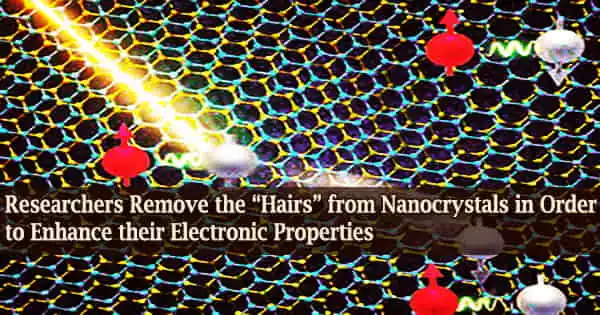Since the 1950s, the components of technology have shrunk to the point where you can now carry a whole computer in your pocket. However, scientists will need to develop whole new technology at the smallest scales in order to produce future generations of electronics, such as more potent phones, efficient solar cells, or even quantum computers.
Nanocrystals are one topic of interest. Although these small crystals may arrange themselves into a variety of forms, researchers have had difficulty getting them to communicate with one another.
A recent work makes a significant advancement in the electronic assembly of nanocrystals. The study, which was published on March 25, 2022 in Science, may pave the way for future gadgets with enhanced capabilities.
“We call these super atomic building blocks, because they can grant new abilities for example, letting cameras see in the infrared range,” said University of Chicago Prof. Dmitri Talapin, the corresponding author of the paper.
“But until now, it has been very difficult to both assemble them into structures and have them talk to each other. Now for the first time, we don’t have to choose. This is a transformative improvement.”
According to Josh Portner, a chemistry Ph.D. student and one of the study’s primary authors, the researchers’ design guidelines should enable the development of a wide range of materials.
A tiny problem
Metals, semiconductors, and magnets can all be used to create nanocrystals, and each will produce crystals with a unique set of features. The issue was that whenever scientists attempted to group these nanocrystals into arrays, more supercrystals would form surrounding them with lengthy “hairs.”
Electrons found it challenging to move from one nanocrystal to another because of these hairs. The messengers of electronic communication are electrons, and the ability of electrons to travel freely is a crucial component of any electronic device.
We call these super atomic building blocks, because they can grant new abilities for example, letting cameras see in the infrared range. But until now, it has been very difficult to both assemble them into structures and have them talk to each other. Now for the first time, we don’t have to choose. This is a transformative improvement.
Prof. Dmitri Talapin
To pack the nanocrystals in more snugly and close the spaces between them, the researchers sought a technique to lessen the hairs around each one.
“When these gaps are smaller by just a factor of three, the probability for electrons to jump across is about a billion times higher,” said Talapin, the Ernest DeWitt Burton Distinguished Service Professor of Chemistry and Molecular Engineering at UChicago and a senior scientist at Argonne National Laboratory. “It changes very strongly with distance.”
They wanted to know what was happening at the atomic level in order to remove the hairs. They need the assistance of strong X-rays at the Center for Nanoscale Materials at Argonne and the Stanford Synchrotron Radiation Lightsource at SLAC National Accelerator Laboratory, as well as strong simulations and models of the relevant chemistry and physics.
All of these enabled them to comprehend what was occurring on the surface and discover the secret to maximizing their output. Supercrystal growth involves liquid solutions for a portion of the process.
In fact, the crystals undergo an extraordinary metamorphosis as they grow in which solid, liquid, and gas phases coexist. They were able to produce crystals with harder, thinner exteriors that could be packed in much more closely by accurately regulating the chemistry of that stage.
“Understanding their phase behavior was a massive leap forward for us,” said Portner.
Although the complete scope of applications is still unknown, the researchers can come up with a number of potential uses for the method.
“For example, perhaps each crystal could be a qubit in a quantum computer; coupling qubits into arrays is one of the fundamental challenges of quantum technology right now,” said Talapin.
Portner is also interested in exploring the unusual intermediate state of matter seen during supercrystal growth: “Triple phase coexistence like this is rare enough that it’s intriguing to think about how to take advantage of this chemistry and build new materials.”
Researchers from the University of California, Berkeley, Northwestern University, Technische Universität Dresden, Arizona State University, SLAC, and the Lawrence Berkeley National Laboratory participated in the study.
The Center for Nanoscale Materials at Argonne, the Midwest Integrated Center for Computational Materials, the Advanced Materials for Energy-Water Systems Center of the DOE, and the Stanford Synchrotron Radiation Lightsource at SLAC National Accelerator Laboratory all had a role in the research.
Funding:
U.S. Department of Energy, U.S. Department of Defense, National Science Foundation, Arnold and Mabel Beckman Foundation, Alfred P. Sloan Foundation, David and Lucile Packard Foundation, Camille and Henry Dreyfus Teacher-Scholar Awards, Sherman Fairchild Foundation.





